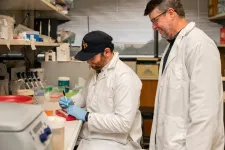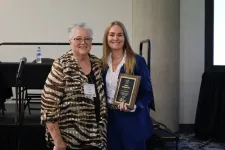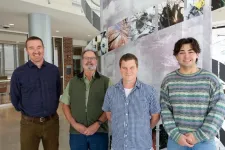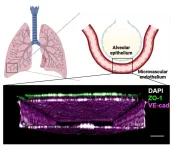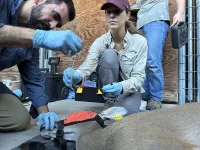Researchers test seafloor fiber optic cable as an earthquake early warning system
2023-10-17
(Press-News.org) One of the biggest challenges for earthquake early warning systems (EEW) is the lack of seismic stations located offshore of heavily populated coastlines, where some of the world’s most seismically active regions are located. In a new study published in The Seismic Record, researchers show how unused telecommunications fiber optic cable can be transformed for offshore EEW.
Jiuxun Yin, a Caltech researcher now at SLB, and colleagues used 50 kilometers of a submarine telecom cable running between the United States and Chile, sampling seismic data at 8,960 channels along the cable for four days. The technique, called Distributed Acoustic Sensing or DAS, uses the tiny internal flaws in a long optical fiber as thousands of seismic sensors.
Yin and colleagues used the cable data to determine earthquake locations and estimate earthquake magnitudes for one onshore (magnitude 3.7) and two offshore (magnitude 2.7 and 3.3.) earthquakes during the study period.
Their results show that using this single DAS array offers an approximate three-second improvement in earthquake early warning compared to onshore DAS arrays. In a simulation run by the researchers, they found that by deploying multiple DAS arrays spaced 50 kilometers apart and working together in the area, they could improve EEW alert times in the subduction zone by five seconds.
“While we did expect some improvements due to the offshore placement of the DAS array, the actual speed gains were beyond our initial projections,” Yin said. “The key advantage is the array's offshore location, which eliminates the need to wait for seismic waves to reach land-based stations.”
The region offshore from Chile is similar to that of the Cascadia region offshore from Canada and the U.S. Pacific Northwest. Both areas contain an active subduction zone, where tectonic plates collide and one plate plunges beneath another, causingsome of history’s largest and most destructive earthquakes. Even offshore of Southern California, numerous faults have hosted magnitude 6 or larger earthquakes. In all of these densely populated coastal areas, offshore earthquake early warning could help protect lives and property.
“The primary reason for selecting this cable is Chile’s elevated seismic risk. The region experiences frequent offshore earthquakes and has been affected by several significant magnitude 8+ earthquakes in history, including the largest ever recorded in 1960,” Yin explained. “Given the high seismic risk and potentially devastating impacts of a large earthquake, there’s a pressing need for a reliable offshore earthquake early warning system in Chile.”
The researchers used a deep learning artificial intelligence model, which is trained and validated on previous seismic and DAS data, to pick out the earthquake waves from the DAS data of this offshore cable. “In the specific case of DAS, the volume of data collected is substantial. For real-time applications like EEW, pre-trained deep learning models provide a highly efficient and reliable option,” Yin said. He noted, however, that other traditional seismological methods of picking earthquakes can still be effective in processing DAS data with automation.
Yin said researchers need more data, especially from larger magnitude earthquakes, to develop and test EEW algorithms effectively, as well as more information on how DAS instruments respond before building a real-time EEW system that integrates with existing EEW frameworks.
There are plenty of places around the world to continue this research, he noted.
“There are more than 1500 cable landing stations around the globe, and the progress in the technology permits the use of operational cables and adding DAS systems without affecting [telecommunications] data transportation.” Yin said. “We believe that this opens up a host of exciting research opportunities, and we are keen to explore these in future studies. We are looking for close interactions with cable owners, environmental agencies, and policymakers to scale the DAS-EEW for the benefit of coastal communities.”
END
ELSE PRESS RELEASES FROM THIS DATE:
2023-10-17
A team of researchers at the Texas A&M University School of Veterinary Medicine & Biomedical Sciences (VMBS) has received a grant from the National Institutes of Health (NIH) to research metabolism in people with Down syndrome.
By targeting genes that affect metabolism, the team may be able to develop drug therapies for physical and mental symptoms of the condition, like muscle loss, accelerated aging, and lower cognitive function, thereby improving the quality of life for people with Down syndrome.
The new grant will also make Dr. Weston Porter, a professor in the VMBS Department of Veterinary Physiology & Pharmacology and lead researcher ...
2023-10-17
In a world that relies on high-speed internet and seamless communication, the absence of a reliable fiber connection can be a significant hurdle. Fortunately, a cutting-edge technology known as free-space optical communication (FSO) offers a flexible solution for field-deployable high-speed wireless communication in areas where fiber connections are unavailable.
FSO has garnered attention for its versatility across various scales of operation. On a global level, it plays a crucial role in establishing high-speed satellite internet projects like Starlink, ensuring global connectivity. At the ground level, ...
2023-10-17
BATON ROUGE – The Obesity Society – the leading professional society focused on obesity science, treatment and prevention – has named Pennington Biomedical’s Dr. Leanne Redman as the recipient of the 2023 TOPS Research Achievement Award. The award, which is funded by the Take Off Pounds Sensibly, or TOPS, Foundation, was presented to Dr. Redman on Monday, Oct. 16, in recognition of her contributions to research in the field of obesity.
Considered by many to be the top award for obesity research, Dr. ...
2023-10-17
CAMBRIDGE, Mass. -- Anyone who has ever tried to pack a family-sized amount of luggage into a sedan-sized trunk knows this is a hard problem. Robots struggle with dense packing tasks, too.
For the robot, solving the packing problem involves satisfying many constraints, such as stacking luggage so suitcases don’t topple out of the trunk, heavy objects aren’t placed on top of lighter ones, and collisions between the robotic arm and the car’s bumper are avoided.
Some traditional methods tackle this problem sequentially, guessing a partial solution ...
2023-10-17
Glioblastoma is the most common type of brain tumor that affects adults and, unfortunately, still remains incurable. In a new study, researchers have demonstrated that a specific mitochondrial protein plays an important role in glioblastoma, and can therefore be used as a potential target to reduce tumors.
“Glioblastoma is notorious for its lethality. One of the major challenges is that it spreads invasively throughout the brain. We’re interested in understanding what drives this process in order to identify new therapeutic strategies,” said Brendan Harley (RBTE leader/EIRH), the Robert W. Schaefer Professor of Chemical ...
2023-10-17
Key takeaways
Whaling in the 20th century destroyed 99% of the Eastern North Pacific fin whale breeding population.
Because there is enough genetic diversity, current conservation measures should help the population rebound without becoming inbred.
The future of fin whales in the Gulf of California depends on the recovery of the Eastern North Pacific population.
A new genomic study by UCLA biologists shows that whaling in the 20th century destroyed 99% of the Eastern North Pacific fin whale breeding, or “effective,” population — 29% more than previously thought.
But there is also some good news: Genes among members of this endangered ...
2023-10-17
By Benjamin Boettner
(Boston) — The lung is one of the tissues most sensitive to radiation in the human body. People exposed to high radiation doses following nuclear incidents develop radiation-induced lung injury (RILI), which affects the function of many cell types in the lung, causing acute and sustained inflammation, and in the longer term, the thickening and scarring of lung tissue known as fibrosis. RILI also is a common side effect of radiation therapy administered to cancer patients to kill malignant cells in their bodies, and can limit the maximum radiation dose doctors can use to control their ...
2023-10-17
Texas A&M University scientists and research partners have received two National Institute of Food and Agriculture (NIFA) Agriculture and Food Research Initiative (AFRI) grants to study the spread of SARS-CoV-2 in deer. These funds will help researchers understand the impact of the virus in Texas’ deer populations and its relationship to human and ecological health.
For these projects, the research team will focus on captive deer, which are an agricultural species in Texas, including managed deer that live on large, rural properties enclosed by fences, as well as on the wild deer with which captive deer may interact and deer living ...
2023-10-17
SAN ANTONIO - October 17, 2023 — Southwest Research Institute has developed a unique technology (US20230242487A1) that enables the safe and efficient synthesis of organophosphorus nerve agent (OPNA) oxime antidotes. Using this technology, SwRI scientists can not only successfully synthesize currently known highly effective nerve agent countermeasures, but also effectively develop promising new drug candidates to treat nerve agent exposure.
Current treatments for OPNA exposure have not changed significantly since the 1950s. OPNAs are odorless and colorless chemicals ...
2023-10-17
October 17, 2023—The Foundation for Angelman Syndrome Therapeutics (FAST) announced today that the non-profit organization has entered into an exclusive global collaborative research and development agreement with the University of Pennsylvania to develop an investigational adeno-associated virus (AAV) gene therapy for Angelman syndrome (AS).
Angelman syndrome is a nondegenerative neurogenetic disorder that is estimated to impact approximately 1 in 15,000 births, or potentially 500,000 individuals world-wide, ...
LAST 30 PRESS RELEASES:
[Press-News.org] Researchers test seafloor fiber optic cable as an earthquake early warning system
